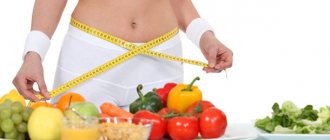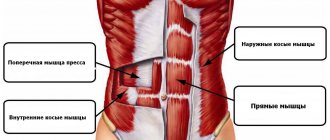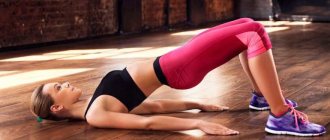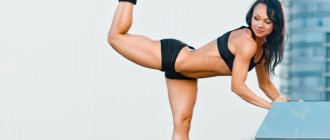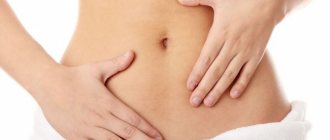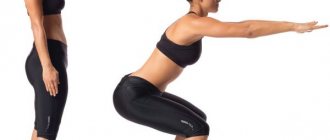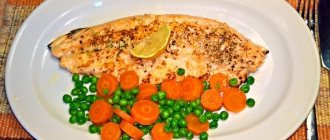Abdominal drying is a set of exercises and a dietary nutrition system aimed at reducing the amount of visceral fat. This fat accumulates in the abdominal area and is necessary to protect internal organs from external influences. But its excess can lead to obesity and other related health problems.
Concept
The main principle of drying the abdomen is to reduce the amount of fatty tissue and create relief in the abdominal area. But you cannot dry only this part of the body. Together with the belly, the amount of fat will decrease in other parts of the body.
The ultimate goal of cutting the belly is to reduce the amount of fatty tissue and create an attractive image. Training will make muscle tissue more elastic and dense, and muscle relief will be noticeable on the surface of the body. If you follow the recommendations, the total amount of fat in the body will decrease, your weight will become lighter, and your body will become more toned.
The concept of “drying the belly” is due to the fact that the process implies a maximum reduction in the amount of carbohydrates consumed. But they are the main supplier of energy for humans, so training will not be easy. After some time, a person will begin to feel a lack of energy, but the intensity of training should not decrease. It is necessary to perform the whole range of strength and aerobic exercises, which will not be easy. Therefore, before starting classes, it is recommended to prepare mentally for the upcoming difficulties.
Recommendations for drying the belly
Achieving a flat and beautiful tummy at home is not an easy task for girls. Drying the abdomen for men is no different from women, but the stronger sex, due to their structural features, can achieve success much faster. It is important not to harm the body. Therefore, you should familiarize yourself with the advice of sports professionals:
- It is necessary to gradually remove fats and carbohydrates from the daily diet;
- 80% of food should be consumed before 18-00;
- dairy products that exceed 15% in fat content should be discarded;
- “forget” about sweets, fast food;
- the last meal should take place no later than 3 hours before going to bed;
- the daily diet should be divided into 5 meals;
- You need to train at least 3-4 times in 7 days;
- You should devote at least 40-45 minutes to training;
- power loads on the press are carried out with high intensity;
- the break between exercises should not exceed 10-12 seconds;
- when consuming foods, a 1.5-hour interval should be observed before and after training;
- 20 minutes before the start of classes, you should drink a glass of water; it is also recommended to drink it throughout the entire workout to saturate the muscles with fluid;
- You need to drink at least 2 liters of water throughout the day.
A set of exercises for drying the belly should be performed regularly, without skipping. The intensity of training should increase gradually. If you don’t build it up and train irregularly, then there will be little benefit from such exercises.
Monthly menu
Once an athlete understands what is possible and what is not, he can begin to create a nutrition program. While cutting, there is a monthly offer to help you lose weight. It's true that you need to start your diet carefully, gradually increasing the amount of protein and decreasing the amount of carbohydrates and fats.
1 step. The BJU ratios are: 50%: 20%: 30%.
- The menu for any day may differ, but it looks like this:
- Breakfast: 200 g of cottage cheese, 2 diet bread with peanut butter, 1 piece of fruit.
- Lunch: apple, handful of almonds. 200 g steamed fish, 100 g buckwheat, 100 g salad with vegetable oil. Snacks: 200 ml kefir, 2 cookies.
- Dinner: 150 g boiled chicken, 100 g stewed vegetables, 100 g barley. The question of what you should eat after exercise is a valid one. You can eat steamed vegetables after your workout.
Step 2: The percentage of carbohydrates is reduced as much as possible. BJU ratios: 70%: 20%: 10%. Duration of the step is 1 week. It is recommended to consume slow carbohydrates before 14:00. You need to leave toast, fruits, and reduce the proportion of grains. We prepare dishes. Everything else is the same as in the last step.
Step 3 is to remove water from the body and completely get rid of carbohydrates. The athlete knows how to drink distilled water. Other items are limited in quantity.
Example of the 1st day of the week menu: 120 g vegetable salad, 7 boiled proteins, 1 tbsp. spoon of porridge. 2 tbsp. L. spoon of boiled porridge, 120 g of meat, 1 vegetable. 200 g stewed vegetables. You can take a protein drink for drinks. 200 g of boiled seafood, greens.
Step 4 you must return the amount of long carbohydrates. The diet should be maintained for 5 to 6 days.
In the first week of drying the body, it is allowed to consume small amounts of slow carbohydrates. Calculate: the amount of carbohydrates per week is equal to 2.5 g per kilogram of body weight. Slow, that is, healthy carbohydrates include brown rice, oatmeal, buckwheat, unsweetened vegetables (potatoes and sweet potatoes are prohibited), fruits with a low glycemic index (bananas, grapes are prohibited). In the second week of drying the body, the amount of carbohydrates is reduced to 1 g per week.
During the drying period, girls should give preference to turkey, white chicken, seafood, raw vegetables and some fruits. Plant fiber quickly saturates the body, stimulates intestinal motility and removes harmful waste products from the body.
- In pursuit of six packs: cutting training program
Monday
- Breakfast - buckwheat or oatmeal, a handful of unsweetened berries, green or herbal tea without sugar.
- Snack - 150 g cottage cheese, 50 g nuts.
- Lunch - turkey with boiled buckwheat, cabbage and carrot salad with a drop of flaxseed or olive oil.
- Snack - half an avocado, shrimp (100 g), olives, green apple.
- Dinner - baked vegetables (broccoli, peppers, zucchini) chicken breast (150 g).
Tuesday
- Breakfast - 150 g of cottage cheese, a handful of nuts, tea without sugar.
- Snack - baked pumpkin, cabbage and celery salad with a drop of olive oil.
- Lunch - pureed vegetable soup, omelette with spinach and peas in the oven.
- Snack - a glass of kefir, half an avocado.
- Dinner - veal steak, green vegetable salad.
- Breakfast - boiled brown rice, 50 g of hard cheese, black coffee or tea without sugar.
- Snack - smoothie made from celery, carrots and green apple.
- Lunch - 2 boiled eggs, salad of mushrooms, green vegetables and walnuts with a drop of flaxseed oil.
- Snack - unsweetened natural yogurt with a spoonful of dried oat bran, a piece of soy tofu.
- Dinner - boiled fish (200 g), vegetable salad (tomatoes, arugula, olives).
Thursday
- Breakfast - grainy cottage cheese with a handful of nuts and berries, green tea without sugar.
- Snack - grapefruit, a glass of kefir.
- Lunch - fish broth without potatoes, baked Brussels sprouts with grated cheese.
- Snack - 2 boiled eggs.
- Dinner - stewed mussels, salad of tomatoes, tuna and green vegetables.
Friday
- Breakfast - 4 egg whites, a glass of kefir with cinnamon, an orange.
- Snack - a handful of walnuts.
- Lunch: brown rice risotto with mushrooms and tofu.
- Snack: apple and celery smoothie.
- Dinner - boiled shrimp, green vegetable salad.
Saturday
- Breakfast - cottage cheese pancakes without sugar on oatmeal, green tea without sugar.
- Snack - a handful of almonds.
- Lunch - boiled fish, baked pumpkin.
- Snack – fruit salad of your choice with cinnamon.
- Dinner - beef steak, stewed cabbage and green beans.
Sunday
- Breakfast - oatmeal on water with berries, tea or coffee without sugar.
- Snack - 50 g of hard cheese.
- Lunch - chicken broth, green salad with olives.
- Snack - a handful of almonds, a glass of kefir.
- Dinner - baked fish, salad of tomato, cucumber, Chinese cabbage and half an avocado.
Tips for proper nutrition
Without following a diet, you will not be able to achieve a flat, beautiful tummy. But when choosing a dietary nutrition system, you should take into account that you should definitely have breakfast. During breakfast, a person receives the main energy boost for the day. For dinner, it is recommended to choose light food.
For greater results, you should familiarize yourself with the advice of bodybuilders:
- Once every 7 days it is recommended to increase the daily amount of calories consumed. For example, if the daily diet consists of dishes with a nutritional value of 2000 kcal, then on one day you should increase the calorie content of food to 2500–2800 kcal. This need is explained by the fact that a long course of dietary nutrition helps to reduce the production of the hormone leptin, which is responsible for metabolic processes in the body. And an increase in calories and the amount of carbohydrates consumed activates the production of the hormone.
- It is recommended to drink cold water. In this case, the body begins to produce energy to heat the cold liquid, which helps burn calories.
- According to scientists, calcium activates the burning of fat cells, so you need to eat foods rich in calcium.
- Eat fruits that help break down fat. These include grapefruit.
- Introduce soy protein into your diet. It helps break down fat cells and build muscle mass.
- Calorie expenditure should exceed their consumption.
Advantages
Drying is believed to help the body rid itself of toxins. This is a myth. The toxin is also not a specific chemical. They can become something else.
Lots of oranges? Toxin. Lots of cabbage? Toxin. Water? Well, you found it out. Removing toxins is not responsible for sweating, muscle activity or drying food is defecation.
- Lethargy and exhaustion. You will have to work through a grueling diet and even more strenuous exercise. During cutting, most boys feel decidedly in good shape.
- Low body weight. If you don't eat well, your body will quickly gain weight immediately after the cycle. This will be done with the expectation of resuming the fast in the future.
- Kidney and bladder problems. An excessive amount of protein in the diet increases the load on these organs. The most unfavorable outcome is swelling.
- Reduced absorption of vitamins K, A, E and D. Subcutaneous adipose tissue is partially involved in their absorption. Guess what happens when he suddenly disappears?
- Problematic skin and nails. Difficulties arise due to poor absorption of vitamins. Menstrual irregularities. Sudden changes in diet can lead to secondary amenorrhea.
Realizing this, I discourage the girls from drying out, but I still silently acknowledge their persistence. I understand that you are not interested in any beliefs, so I will tell you how to reduce the bad consequences of this gastronomic nightmare to zero.
Express drying of belly fat: diet
Drying the belly for girls at home involves the use of a certain dietary pattern. A large number of such schemes have been developed. It is necessary to choose the one that is more suitable and corresponds to the level of physical activity of a person. You can choose a strict or more gentle diet.
Drying the belly for girls: diet with fasting
One of the belly drying schemes for girls involves daily fasting for 16 hours. During the day, you must choose a 16-hour period during which you should completely abstain from eating. During the remaining time, you need to eat your entire daily food intake. During fasting, the body will begin to intensively burn fat cells to support its activities. Food should be rich in proteins. If foods containing carbohydrates are present, they should be slowly digestible.
When using such a nutrition system, you should also create a calorie deficit. If they are insufficient to ensure the body’s activity, the burning of existing fat reserves will begin.
Diet for drying the belly of a woman with a low carbohydrate content
Nutrition for drying the abdomen for women according to this scheme implies a gradual transition to this type of dietary nutrition. The course lasts 4 weeks and consists of the following:
- During the 1st week you should completely give up sweets. You need to have breakfast with foods rich in complex carbohydrates. Lunch should consist of dishes with an equal ratio of proteins and complex carbohydrates. It is recommended to have protein foods for dinner.
- During the 2nd and 3rd weeks you need to give up flour foods. The main emphasis is on eating various cereals (buckwheat, rolled oats, rice, etc.). At the end of the 2nd week, complex carbohydrate foods should be eaten in the first half of the day.
- In the last week, it is recommended to count carbohydrates. Their consumption is determined by the ratio: 1 g of carbohydrates per 1 kg of weight. A significant part of the daily diet should consist of protein foods: chicken breast, kefir, cheese, eggs.
The above nutritional systems for drying the belly should be considered exemplary. Each of them must be adapted to your body and level of stress.
Nutrition for drying the body: a full menu (carbohydrate microcycles)
Carbohydrate rotation is one of the most common and at the same time effective diets, which helps to dry out your body shape through a competent approach to creating your menu.
To prevent such a deplorable situation for fat burning, microcycles were introduced, that is, the menu will include days with a high carbohydrate content and days with a low content (usually the classic scheme implies 2 1, that is, two days with a low carbohydrate content and one with elevated).
Thus, in order to comply with all the conditions of carbohydrate alternation, according to the classical scheme, you will need to consume no more than 1 gram/kg of body weight of carbohydrates in the first two days of the diet, and 2.5-3 grams/kg of proteins; on the third day, the amount of carbohydrates is increased up to 4-6 grams/kg, and proteins 1-1.5 grams/kg.
Using the above method, in the first two days the body almost completely depletes glycogen reserves, actively switching to fats to cover energy costs. Further, if you continue fat burning under such conditions, the body may fall into a stressful state that is life-threatening, as a result of which not only fat burning will stop, but also muscles (proteins) will be used as a source of energy.
A complete diet for an athlete during cutting
To prevent this situation, a third, carbohydrate-loading day was introduced, during which the amount of carbohydrate food in the diet increases, protein is reduced, and fat consumption is reduced to zero, in order to replenish glycogen reserves in the muscles and liver and continue the fat burning process (often one high-carbohydrate day is not enough to replenish glycogen stores, so another day of moderate carbohydrate consumption is introduced).
Weight loss with carbohydrate alternation, in the classic version described above, is not uniform, due to the fact that most of the kilograms lost in the first two to three days return along with liquid (1 gram of carbohydrates binds 4 grams of water) on day 4-5 diet, but already in the morning of day 6, the weight becomes the same as it was at the beginning of the carbohydrate load (on average minus 0.5-1 kg).
This list of food products is designed specifically for the diet (carbohydrate rotation). They can and should be included when developing your menu for drying the body, and some should be excluded altogether.
Composition of a diet for drying the belly
Drying your belly will require the following foods in your daily diet:
- grain bread:
- various cereals;
- egg (mostly white);
- green apples, grapefruits;
- natural yoghurts, kefir, cottage cheese with the lowest fat content;
- vegetables (except potatoes);
- lean meats, steamed, boiled, baked;
- fish, seafood;
- dried fruits, seeds, nuts;
- vegetable oils based on olive, flax, Omega-3.
If it is not possible to eat food 5 times a day, then you can replace it with protein shakes. They saturate the body with proteins and do not contain fats and carbohydrates that are harmful during drying the belly.
Eating red and white fish will enrich the body with Omega-3 and other useful components that enhance the fight against excess weight. Also, such food will speed up metabolic processes, prevent heart problems, and destroy cholesterol plaques.
Drying entrance
Drying does not start suddenly. This is the most strict diet for which the body must be prepared. Therefore, you should reduce your protein intake to a maximum and carbohydrates to a minimum 2-3 weeks before drying. This means that all unhealthy foods, from muffins and pastries to smoked foods, should be excluded from the diet.
They remain in food: whole grain bread, cereals, pasta made from rye flour, as well as durum wheat. Of course, the basis of the diet will be protein foods such as meat, fish, legumes and low-calorie milk.
Drying was invented for athletes, and in an unusual form it means 4 periods. During each drying period, the small daily calorie intake should be above 1200 kcal. Failure to follow this instruction may result in serious health problems.
The first drying period takes from 4 to 6 weeks. At this point you should be able to consume 50-60% protein, 10-20% fat and 20-30% carbohydrates (20% is better). The rational calorie content for this period will be 1600 kcal per day. Following this criterion, protein should be 200 g (820 kcal), fat - 34 g (320 kcal), carbohydrates - about 117 g (480 kcal).
Drying the belly for men and women at home: exercises
There is a system of special exercises that is suitable for both sexes. At home, you can do the following:
- Raising the torso from a lying position. To perform the exercise, you should sit with your back on the floor, your legs bent at the knees, your feet flat against the floor, and your hands clasped at the back of your head. The torso, with the help of the abdominal muscles, rises up to an angle of 45⁰. You need to stay in this position for a couple of seconds. Hands should not be involved in lifting the torso. It is recommended to do 3-4 sets of 20 reps each.
- Simultaneous lifting of arms and legs. The starting position does not change. At the same time, the arms and legs rise towards each other. The body should not rise. Approaches and number of repetitions are determined individually.
- Exercise on the horizontal bar. You need to hang on the horizontal bar and slowly raise your legs up until they are parallel to the floor. 15 repetitions will be enough.
- Tilts. Take small dumbbells in your hands and place your feet shoulder-width apart. The arms rise up, the body bends to the right and left sides up to 30 times.
- To perform the “bicycle” exercise, you should lie on the floor, raise your legs at an angle of 90⁰ and imitate riding a bicycle until you have enough strength.
- Creating a "vacuum". In a standing position, while inhaling, you must pull in your stomach with maximum force and stay in this position for 0.5-1 minute. Do at least 3-4 approaches.
- To work out the oblique abdominal muscles, lie on your back and raise your legs bent at the knees to 90⁰. Hands need to be clasped at the back of the head. To perform the exercise, the torso is raised as high as possible using the abdominal muscles. In this case, you need to reach your right knee with your left elbow and vice versa.
- Working out the abs in reverse. The starting position is the same. You should try to pull your legs towards your chest as much as possible, not forgetting about proper breathing.
- The final exercise could be a plank. To perform it, you should lie on your stomach, rise up, resting your elbows and toes on the floor. You should hold out in this position for as long as possible, gradually increasing the time.
Therefore, drying the belly will require significant effort and patience from a person. Moreover, the set of activities is equally suitable for both men and women. Only physical activity and the nutritional value of the food consumed can change.
IMPORTANT! Informational article! Before use, you should consult a specialist.
What cardio workouts are waist cutting compatible with?
If your weight is about 55 kg, then 550 kcal is burned in 1 hour of running. Cycling - 470 kcal, elliptical exercise - 520 kcal, an hour of aerobics - 500 kcal, jumping rope - 570 kcal.
If you weigh 70 kg, 1 hour of running will burn 680 kcal. Cycling - 560 kcal, elliptical training - 625 kcal, aerobics - 600 kcal, skipping (jumping rope) - 700 kcal.
For people weighing 80 kg: an hour of running helps burn 820 kcal. Cycling - 685 kcal, elliptical - 700 kcal, jump rope - 820 kcal.
